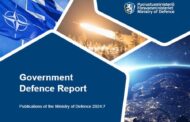Remarks by NATO Deputy Secretary General Rose Gottemoeller at the panel discussion
“Global nuclear governance: Quo Vadis?“
The Bled Strategic Forum (BSF), Slovenia, 05 Sep. 2017
______________________________________________________________________________________________________________________________________
Thank you very much. And thank you for this invitation. The Bled Forum’s put together a really impressive panel this morning, and it’s an honour to be up here on this platform with my esteemed colleagues. I really am delighted to be here this morning.
Many of you know me perhaps as an arms control nuclear non-proliferation expert from my past life. My remarks this morning will be focused on my current responsibilities, which are as the Deputy Secretary General of the NATO Alliance. But I did want to start with one comment since you brought up, you know, where are we going with these nuclear modernization programs in the United States and Russia, and what does that foretell for the future of nuclear arms reduction?
At the moment, I want to stress for all of you here in this audience, and happy to discuss it further, that the restraints of the New START Treaty hold. Both the United States and Russia are continuing to implement the New START Treaty, and they will be obligated by the treaty to reach the reduction levels of the treaty by February of 2018. So that date is coming up fast now. But both sides, even with their programs going on, and in fact New START was negotiated with the Russian modernization program in mind.
So they will be constrained to 500 delivery vehicles, 500 delivery vehicles and no more, and that means 1,550 operationally deployed warheads, no more. Same on the U.S. side. There’s been a lot of, you know, interest in the so-called U.S. modernization program. It’s actually, as I think about it, more of a replacement program. And there’s no talk in either Washington or Moscow right now of moving beyond 500 delivery vehicles and 1,550 operationally deployed warheads. Just, you know, by way of comparison, when the START I Treaty entered into force back in 1994, each side had approximately 12,000 operationally deployed warheads.
So the numbers have come down precipitously in the past 20 years. And I see no reason why that will be reversed by the programs that both Moscow and Washington have in train now to replace older systems, whether ICBMs, intercontinental ballistic missiles, sea-launched ballistic missiles or bomber aircraft.
So again, happy to discuss any of this during our Q&A period, but I do want to stress when you think about what Washington and Moscow have in train in terms of replacing older systems, it does not mean a breakout from the extant strategic arms reduction regimes. We may see that in the future, but at the moment we do not see it.
Now let me turn to… I wanted to bring us back to North Korea with two remarks that were made in recent times. First by my boss, Jens Stoltenberg, the Secretary General of NATO, who this last Sunday, the very day we saw the sixth North Korean nuclear test, put out a statement that said, “I strongly condemn that North Korea has conducted a sixth nuclear test today.” He then went on to say, “NATO is concerned by Pyongyang’s destabilizing pattern of behaviour, which poses a threat to regional and international security.”
That is his statement in part. I won’t read out the whole thing, but I refer you to it as how NATO has been concerned and interested in this matter. And furthermore, this July when we saw a pattern of continued nuclear missile tests, well missile tests with the aspiration, as we understand, from Pyongyang of beginning to load them up with nuclear warheads, the North Atlantic Council – that is our group of permanent representatives representing all 29 members of the Alliance – put out a statement on July 12th, saying, “the North Atlantic Council condemns in the strongest possible terms the DPRK’s unprecedented launch of a ballistic missile of intercontinental range on 4 July, a major escalation that directly violates multiple UN Security Council resolutions, and clearly demonstrates the growing threat posed by the DPRK to the Alliance, to global peace and security, as well as to the global non-proliferation regime.”
I wanted to bring up these two statements this morning again to highlight for you that as far as NATO is concerned, the threat that North Korea is posing is becoming a global matter. This is not a matter only for the Asian countries, for the Asian allies of the United States, the ROK and Japan. It’s not a matter simply for the members of the six party talks who have been engaged for many years now: China, Russia, the United States, ROK, Japan, as well as North Korea. This is a global matter, and one that we have to consider as a global matter. So there are many challenges ahead of us, I think, as we consider what policy efforts must go forward. I think we’ve had an interesting week in terms of the kinds of statements that have been made.
I do not agree with this kind of notion that we can somehow trade off the exercise program that the United States and the ROK conducts against the DPRK’s testing program for both missiles and nuclear weapons. I think we have to bear in mind that this threat was launched way back in 1994 when the DPRK took steps to try to withdraw from the non-proliferation treaty regime. So we have been grappling with this problem for a long, long time, but at its inception it was a problem that emanated from North Korea and from Pyongyang’s push toward acquiring a nuclear weapons program.
But I was very interested in this week in the context of the BRICS Summit that both President Putin and President Xi re-emphasized the necessity of denuclearization of the Korean Peninsula. I think that is a very important objective to restate. Very important for all of us, I think, to be thinking about ways to re-energize efforts to accomplish that goal. Again, happy to discuss it further in our Q&A period, but from the perspective of the NATO Alliance, this is a global challenge that must be addressed. And we are thinking about it in those terms in Brussels at NATO Headquarters.
Q & A
QUESTION: Deputy Secretary General Gottemoeller, how big of a test is the situation on the Korean Peninsula for NATO’s nuclear deterrence policy?
DEPUTY SECRETARY GENERAL: I would characterize it as really a test for U.S. extended deterrence policy per se. It’s not an issue in the NATO context, but the United States of America has extended its deterrent not only to the NATO allies, but to its Asian allies as well, to the ROK and to Japan.
So it is in that way I think influential in how people around the world will look at the strength of the U.S. extended deterrence commitments. We have seen some very strong statements over the weekend, which I welcome very much, from the Secretary of Defence, from Mr. Mattis, emerging from the White House with the Secretary of State, Mr. Tillerson at his side, speaking very strongly about this matter. But in addition, actions do speak louder than words, and I have been quite heartened over, really, the years now that these provocations have been going on from the DPRK, the extent to which the United States working together with the ROK has been willing to convey in a very real sense the strength of its extended deterrent commitments. And probably the most visible way it has done so is by bringing bombers forward and exercising together with ROK forces, but the strategic bomber force has been an excellent instrument in that regard.
But the U.S. extended deterrent, and I’d like to emphasize this constantly, not only in the Asian context but also in the NATO European context, the extended deterrent of the United States does not limit itself to nuclear weapons. It has to do also with the very real capabilities of U.S. conventional forces. Again, in the case of the ROK, exercising and training together with ROK allies. It has to do with missile defence capabilities that have been put in place in Asia in recent years, as in Europe as well, the NATO limited missile defence capabilities.
So… and finally, it has to do with the way in which we exercise and work effectively with our allies to provide for deterrence and defence. We’ve seen that in spades in the European context, in NATO working in recent years, and particularly since the Warsaw Summit in July a year ago to bring deterrence and defence capability forward in the NATO European context to address the very real concerns that we have about Russia these days, but also you see over the years the very effective way that the United States has worked together with the ROK and with Japan so that it’s clear that our conventional forces are interoperable and extraordinarily capable as well.
So I wanted to really stress the reality and the pragmatic operational capability of the U.S. extended deterrence forces as they operate with U.S. allies, both in Asia, as well as in Europe. And I think these days it’s paying dividends in the response to the DPRK, but it’s an issue that requires constant attention, and clearly this matter has gotten Washington’s attention, which I applaud.
QUESTION: That U.S. extended deterrence policy is also facing, as you just mentioned, pressure in other areas. So U.S.-Russia relations have seriously deteriorated since 2014. Where does that leave U.S.-Russia cooperation on arms control and nuclear non-proliferation?
DEPUTY SECRETARY GENERAL: Well I should ask other colleagues, you know, who are working this issue actively. I’m sure Amano-san and Dr. Zerbo might have some things to say about this matter, what they see emanating from Washington currently. Again, my position here today is as Deputy Secretary General of NATO. But I’ll refer only to two things. One is the great legacy of arms control. Between Washington and Moscow with roots back in the inception of the non-proliferation treaty regime, following the Cuban Missile Crisis in the 1960s. So there is a mighty tradition and a mighty legacy of cooperation in these areas, even from the worst days of the Cold War. And it has driven these two countries to build down the major overbuild that was a result of the Cold War nuclear arms race. The United States, for example, had over 31,000 warheads in 1967 at the height of the Cold War. The Russians, by some estimates, and I refer to the former Minister of Atomic Energy, Viktor Mikhaylov, who said publicly at one point that the Soviets built up to 45,000 warheads.
And in the ensuing 45 years since the NPT was negotiated, and quite rightly it was mentioned already by our Kazakh colleague that it will reach its 50th anniversary in two years’ time, three years’ time. Nevertheless, in that ensuing period, both the United States and the Russian Federation have brought those warhead numbers down precipitously from 31,000 in 1967 to just over 4,000 today in the U.S. arsenal.
I spoke about deployed warheads a while ago, 1,550 under the New START Treaty, but then additional warheads held in storage. It’s still too many. It’s still too many. And so clearly we will wait and see the results of the nuclear posture review that is going on in the United States at the present time.
Every new President who arrives in office takes… undertakes a nuclear posture review, and so President Trump is doing the same. But I do expect that there will be some continuity in U.S. policy with regard to nuclear arms control. And I can only hope that Moscow will take that message seriously and be willing to re-engage. I have seen since the Trump administration arrive in office the emergence of some new discussions in the Russian media, in the Russian press, about the importance of continuity in nuclear arms reduction, nuclear arms control. So I hope that that will in fact bear fruit once the Trump administration has completed their review and is ready to move forward in whatever direction they propose.
QUESTION: Madam Gottemoeller, this is the last question before we turn to the audience. Do you agree with Mr. Bylica’s assessment, and is a nuclear weapons ban at this point a good idea?
DEPUTY SECRETARY GENERAL: Well Jacek just made mention of the NATO Alliance and how it is, you know, well obviously co-exists with the European Union and in a very close partnership. We’re very proud of the way we’ve developed our good working relationship with the EU in the recent years, and particularly in the past year since I’ve taken this new job. For me, I’ve seen that partnership develop apace, and it’s very, very welcome. But we are a nuclear armed alliance in Europe, the NATO Alliance, and we have nuclear weapons deployed in Europe, as well as having two, three nuclear weapon states among the five nuclear weapon states under the NPT. So France, U.K., and the United States.
So obviously from the perspective of the NATO Alliance, nuclear deterrence is an important part of extended deterrence, and it is an important part of how the Alliance conducts deterrence and defence. I actually had a question, and perhaps we can further take this up, but if our Kazakh colleague would like to comment on this, I do not see the value added of a nuclear ban treaty. And in fact I see tremendous dangers in a nuclear ban treaty because of the additional international legal requirements it imposes or attempts to impose. And really the way it calls into question at the moment the continued validity of nuclear weapons as an aspect of deterrence.
I don’t see value added also because it is the non-proliferation treaty regime that I referred to a few moments ago that has driven so much impetus to denuclearization over the past 45 to 50 years. And I continue to see that non-proliferation treaty regime paying dividends with regard to denuclearization. The process that occurred with Kazakhstan, Ukraine, and Belarus at the break-up of the Soviet Union in the early 1990s was rooted in the non-proliferation regime, and that these three states, including Kazakhstan… I give huge credit to President Nazarbayev and to Kazakhstan for taking these decisions. But it was that Kazakhstan would become a non-nuclear weapons state under the NPT system, in addition to working with the, at that time, START Treaty, the Strategic Arms Reduction Treaty negotiated between Washington and Moscow, but with all of the countries involved, Kazakhstan, Ukraine, and Belarus, as the instrument by which nuclear delivery vehicles were eliminated from the territories of those countries.
So again, I spoke a moment ago about this tremendous legacy that has bound Washington and Moscow together in nuclear arms reduction and elimination. I see that legacy not only as having a proud past, but having a very real present and a very real future. And so I don’t see the value added of a ban treaty. And in fact, I worry that it undermines the NPT regime.
* * * * *
Zdroj a ilustračné foto: http://nato.int/cps/en/natohq/opinions_146617.htm?selectedLocale=en







